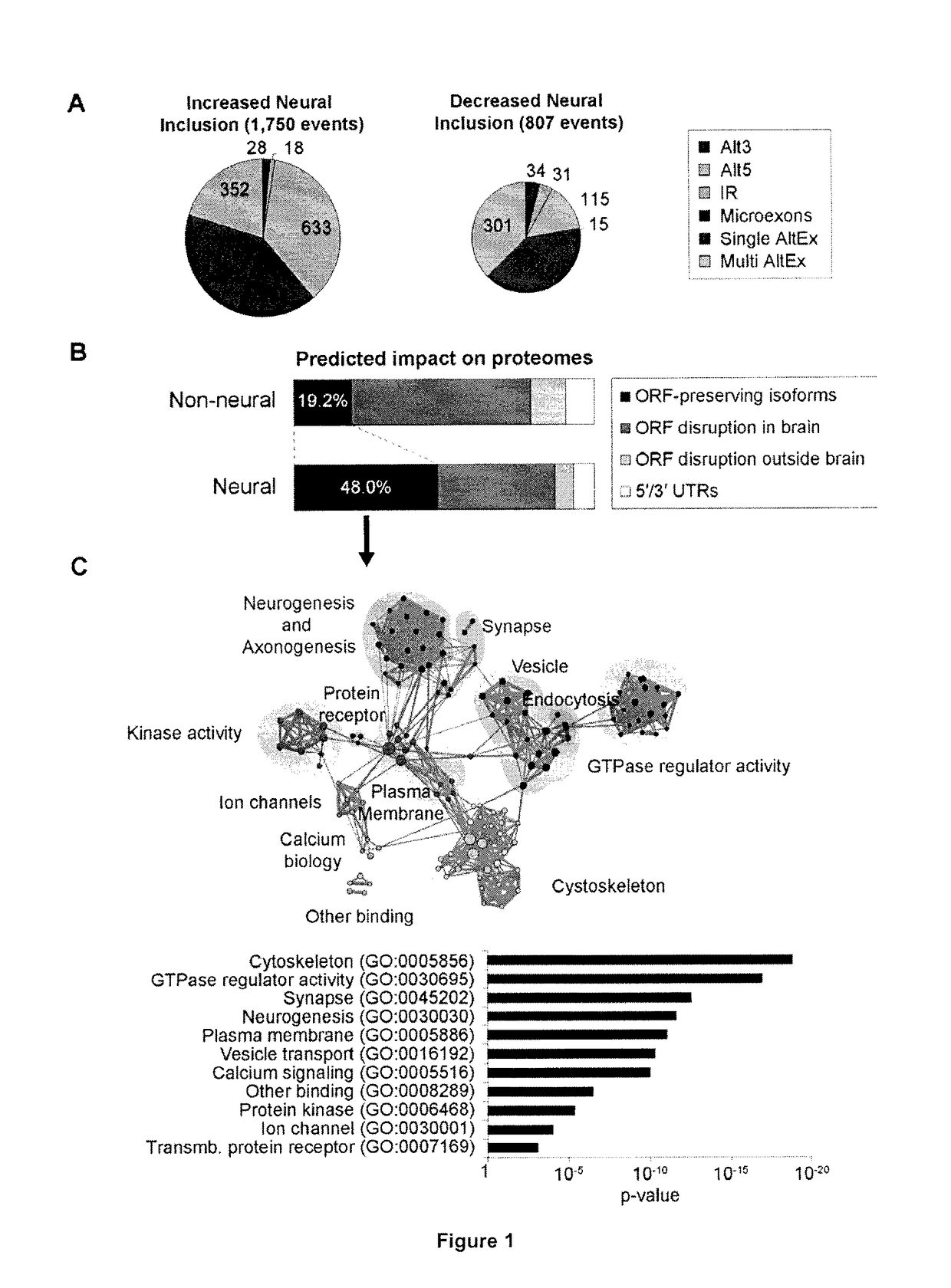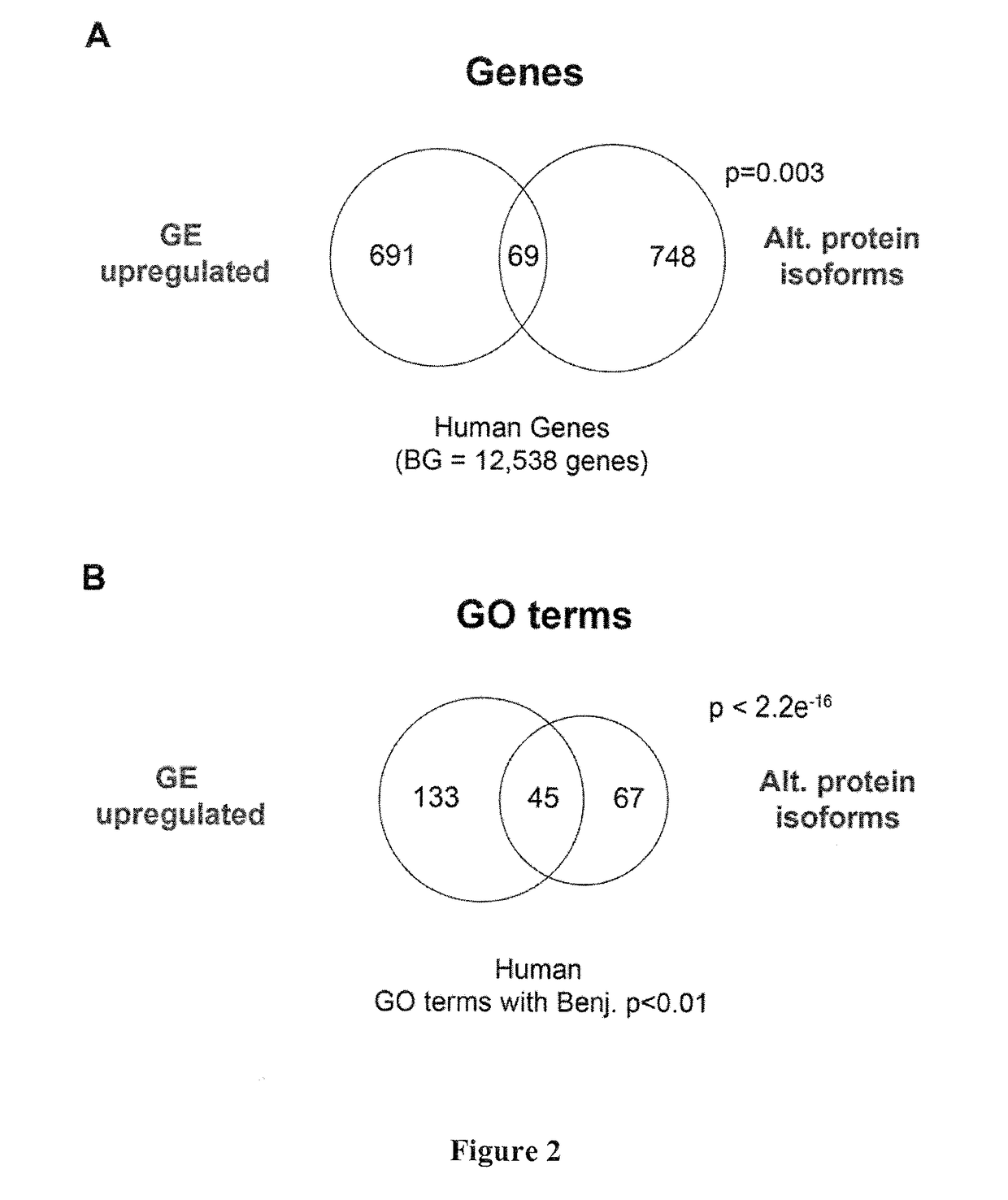Modulation and detection of a neuronal alternative splicing regulatory network for treatment and diagnosis of neurological disorders
a neuronal alternative splicing and regulatory network technology, applied in the field of neuronal alternative splicing regulatory network, can solve the problems of disease states, large misregulation of entire programs, and lack of sensitivity and/or depth required for detecting specific types of rna-seq datasets,
- Summary
- Abstract
- Description
- Claims
- Application Information
AI Technical Summary
Benefits of technology
Problems solved by technology
Method used
Image
Examples
example 1
Regulatory Mechanism for Activating an Exon Network Required for Neurogenesis
Summary
[0214]A new RNA-Seq pipeline was developed for the systematic discovery and analysis of all classes of alternative splicing (AS), including microexons. By applying this pipeline to deep RNA-Seq datasets from more than 50 diverse cell and tissue types, as well as developmental stages, from human and mouse, a large program of neural-regulated AS was defined. Strikingly, neural-included microexons represent the most highly conserved and dynamically-regulated component of this program, and the corresponding genes are highly enriched in neuronal functions. These microexons are enriched on the surfaces of protein interaction domains and are under strong selection pressure to preserve reading frame. It was observed that microexons are frequently misregulated in the brains of autistic individuals, and that this misregulation is linked to the reduced expression of the neural-specific Ser / Arg-related splicing ...
example 2
Roles for the Splicing Regulator nSR100 / SRRM4 During Nervous System Development
Summary
[0237]To investigate the functions of nSR100 and microexons in vivo, mice carrying a conditional exon deletion in the nSR100 (Srrm4) gene that results in widespread loss of the full-length protein were generated. It was observed that nSR100 is essential for early postnatal survival of a large majority of mutant animals, with the few surviving animals displaying balance defects similar to those seen in bv / by mice, but also exhibiting persistent tremors. Additionally, loss of nSR100 in mice results in impaired neurite outgrowth in the diaphragm, defective cortical layering, and a failure of callosal axons to cross the midline in the forebrain. Using a RNA-Seq analysis pipeline, all classes of AS, including alternative microexons, that are controlled by nSR100 in vivo are defined. A large fraction of alternative cassette exons and microexons positively regulated by nSR100 are neurally enriched, which ...
example 3
ting Behavioral and Neurobiological Characteristics of nSR100-Deficient Mice
[0277]nSR100 mutant mice were assessed for their utility as a model for studying human neurological disorders, particularly ASD.
[0278]Autism spectrum disorder (ASD) affects ˜1% of children and is highly heterogeneous with respect to its presentation and contributing genetic factors. By definition, all ASD patients exhibit deficits in socialization and communication. Several genetic syndromes include ASD along with other symptoms, but the majority of ASD cases are of unknown origin. While many genetic variants—some only occurring in a single patient—have been associated with non-syndromic ASD, the genes and genetic programs most strongly contributing to idiopathic ASD have been elusive.
[0279]Down-regulation of the neuronal-specific splicing regulator nSR100 / Srrm4 and disruption of the nSR100-dependent alternative splicing program described hererin was observed in nine (9) of twenty-two (22) analyzed ASD patie...
PUM
| Property | Measurement | Unit |
|---|---|---|
| temperature | aaaaa | aaaaa |
| temperature | aaaaa | aaaaa |
| thickness | aaaaa | aaaaa |
Abstract
Description
Claims
Application Information
 Login to View More
Login to View More - R&D
- Intellectual Property
- Life Sciences
- Materials
- Tech Scout
- Unparalleled Data Quality
- Higher Quality Content
- 60% Fewer Hallucinations
Browse by: Latest US Patents, China's latest patents, Technical Efficacy Thesaurus, Application Domain, Technology Topic, Popular Technical Reports.
© 2025 PatSnap. All rights reserved.Legal|Privacy policy|Modern Slavery Act Transparency Statement|Sitemap|About US| Contact US: help@patsnap.com



